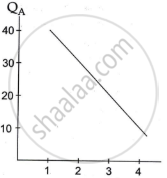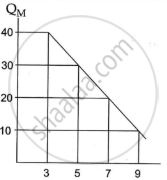Advertisements
Advertisements
Question
| Price (in ₹) | QA (units) | QB (units) | QM (market demand)(units) |
| 10 | 4 | 5 | ______ |
| 20 | 3 | 4 | ______ |
| 30 | 2 | 3 | ______ |
| 40 | 1 | 2 | ______ |
Complete the above schedule and answer the following:
- Identify and state the underlying law.
- State four assumptions of the law.
- Draw three relevant curves based on the above schedule in one diagram.
Long Answer
Solution
| Price (in ₹) | QA (units) | QB (units) | QM (market demand)(units) |
| 10 | 4 | 5 | 9 |
| 20 | 3 | 4 | 7 |
| 30 | 2 | 3 | 5 |
| 40 | 1 | 2 | 3 |
- The above schedule demonstrates the law of demand. According to the law of demand, increasing the price of a commodity leads to decreased demand and vice-versa provided other parameters stay unchanged.
- Assumptions of the law of demand are:
- The price of related commodities, such as substitutes or complementary goods, remains constant.
- The consumer's expectations remain unchanged.
- Consumer income levels remain stable.
- Consumer tastes and preferences remain stable.
shaalaa.com
Is there an error in this question or solution?
APPEARS IN
RELATED QUESTIONS
What are the assumptions of the Law of Demand?
State with reason whether you agree or disagree with the following statement.
Price is the only determinant of demand.
Which is an assumption to law of demand?
Following is not the assumption of law of demand:
Which of these is NOT an assumption of the Law of Demand?



